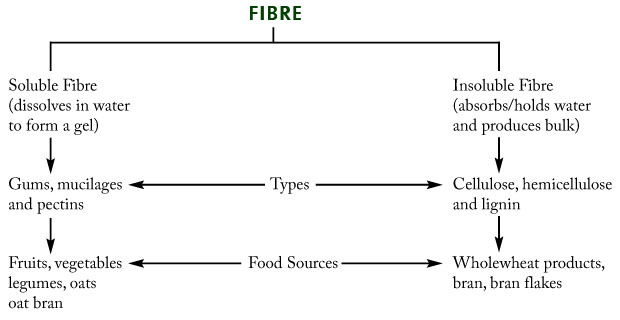Fibre, the essential "non-nutrient"
Dietary fibre is a complex of non-digestible carbohydrates present in the cellular structures of the plant-derived foods we eat. Fibre includes the skins and pulp of fruits and vegetables plus seeds, nuts, beans and grains. It comes to us as five different components in two basic forms. One form is “insoluble” fibre. Its component types are cellulose, hemicellulose and lignin. The second form is “soluble” fibre. Its component types are gums and pectins. Each of these 5 different types of fibre contributes benefits to the overall proper functioning of our digestive tract.
From grandmother's advice to a scientific fact
Just a few short years ago, dietary fibre (referred to as roughage) was considered to be irrelevant to well-being. Only grandmothers, who claimed “you need your roughage every day to stay healthy”, seemed to recognize the value of this important aspect of our diet. However, physicians working in Africa found that certain societies appeared to be free from any diseases common to Western cultures. They found that people in these societies were living on high fibre diets of unrefined, unprocessed foods, and determined that the lack of fibre in the Western diet may be responsible for many common challenges to our well-being.
We don't get enough fibre
Cancer Institutes currently recommend a dietary intake of 25 to 35 grams of fibre per day for adults. The average person consumes only 10 to 20 grams per day - about half of the amount recommended. Considering the importance of dietary fibre, this appears to be a critical weakness in our diet, open to causing problems.
More than just bran
For decades, fibre has been considered synonymous with bran. However, as was mentioned above, fibre is not a single substance, but rather a complex available to our bodies in five major types, each serving a valuable dietary function.
Cellulose and hemicellulose
Cellulose is the most abundant fibre in our foods. It is cellulose which forms the cell walls of plants.
Hemicellulose is a polysaccharide, a complex carbohydrate which combines with pectin to create the matrix, or intercellular substance, in which the cellulose fibres are enmeshed.
Cellulose and hemicellulose contribute to regularity and help to relieve and prevent constipation. These substances remain virtually unchanged as they pass through the digestive tract, adding bulk and absorbing water along the way. The additional volume increases the speed at which food moves through the digestive tract.
Gums and pectins
Gums are the “soluble” portion of fibre, part of the pulp of plants. Pectin is the gel-like constituent that acts as a binding agent for the fibre structure within plants.
Lignin
Lignin is a woody substance that helps to support the walls of the plant cell. It helps move food through the gastrointestinal tract more quickly.
The fibre challenge
Putting back the 10-20 grams of fibre we need each day can present a real challenge in this age of processed and refined foods. Plus, fruits, vegetables and grains vary considerably in the amounts and types of fibre they contain. For example, leafy cabbage, young peas and other immature plants have a good deal of cellulose, but only a small quantity of lignin. Bran, on the other hand, supplies high levels of cellulose, hemicellulose and lignin, but contains no pectin or gums.

Research indicates that a complete mixture of the different types of fibre is necessary for optimum physiological functioning.
GNLD bridges the gap
All of the above knowledge is reflected in the formulation of GNLD’s fibre based products.
Product |
Fibre |
| Fibre Tablets (4 tablets) | 2 grams |
| Multi-Fibre Blend | 7 grams |
Each product provides a combination of soluble and insoluble fibre from a variety of different fruits, vegetables, nuts and grains.